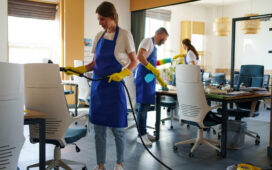Commonplace items are often overlooked when it comes to workplace health and safety. This is particularly prominent with cleaning products — but it is vital to remember these products are chemicals and need to be used and stored correctly to keep employees safe. One shot drain cleaner supplier, Fulcare, investigates further.
Storage basics
Let’s look at the basics. Firstly, the storage area for your cleaning products should be cool and dry. It’s important that they aren’t stored anywhere that could heat up or cool down suddenly, due to proximity with running equipment for example.
Also, where possible, cleaning products should be stored in their original containers. For one, this should prevent any mix-up with other products, thereby reducing the risk of accidentally mixing two chemicals that should be kept apart: for example, a powerful drain cleaner such as one shot drain cleaner products should not be used if bleach or other chemicals have recently been used on the drain.
COSHH
COSHH (Control of Substances Hazardous to Health) is likely already a well-known regulation to your workplace, especially if you use chemicals as part of your processes. COSHH also applies to cleaning products held in the workplace. The Health and Safety Executive points out example risks associated with cleaning products and the cleaning process, including:
- Skin allergies
- Eye damage
- Dermatitis
- Asthma
- Burns
Changes to the CLP hazard pictograms
It’s important to stay up to date with health and safety changes. For example, as of 2015, the hazard pictograms on products have been updated from the old orange-and-black symbols to new red-and-white versions. The old “X” symbol for irritant has been replaced entirely. This is to make the pictograms more universal, as well as covering a few new areas. The pictograms you may now come across on cleaning chemicals are:
- Oxidising, which uses a flame over a circle in its picture
- Corrosive, which uses a vial pouring onto a hand and a surface in its picture
- Acute toxicity, which uses a skull and crossbones picture
- Explosive, which uses an exploding bomb picture
- Flammable, which uses a flame picture
- Hazardous to the environment, which uses a dead tree and dead fish in its picture
- Health hazard and/or hazardous to the ozone layer, which uses an exclamation mark picture
- Serious health hazard, which uses a picture of a person’s head and shoulders with a starburst from the centre of the picture
- Gas under pressure, which uses a gas cylinder picture
Ensure the proper storage and use of cleaning products will reduce these risks. Let’s look now at the correct practice for using cleaning products safely in the workplace.
Chemical-containing cleaning products
Initial risk assessment
The European Cleaning Journal recommends carrying out a risk assessment for any new cleaning product you purchase. This assessment will help to identify specific cleaning products and processes that could have risk-reduction actions in place, as well as reviewing that current processes are being adhered to. Alongside this, you need to check that these processes are working; if not, they will need amending. As previously mentioned, if the risk assessment brings to light any particular handling, storage, or usage requirements for a certain cleaning product or equipment, the next step needs to be putting a process in place. This process should be tailored to reduce any risk associated with the product.
Be sure to safely store the necessary paperwork for these products too. Any cleaning products purchased for the workplace should come with instructions for their safe use, as well as a chemical safety data sheet where applicable. Be sure to follow these instructions given, as well as using the data sheet to help bolster your risk assessment.
The benefit of training
The processes and correct procedures to follow when using these chemicals should be clearly relayed to staff. Be sure to set aside time to train staff in any hazardous products with new processes in place and make space for safety posters in clear view. It is important that your staff have as little contact with potentially harmful products as possible. Supplying adequate PPE for staff using chemical cleaning products can help with this.
Cleaning products can often be overlooked in terms of risk, but they are still chemical in nature. Be sure to keep your workplace safe with necessary procedures and protective equipment.







